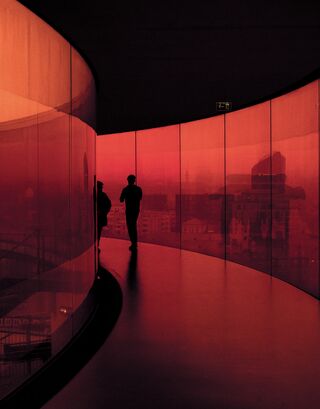Relationships
Red Is Associated with Love, but Do We Actually Feel It?
Associations between colors and emotions are not about feelings.
Posted February 13, 2022 Reviewed by Gary Drevitch

Close your eyes and imagine the color red. Then, think about the emotions that go with this color. You might think of love or anger, potentially also of hate or passion. You might think of all of them, only one of them, or a totally different emotion (see our previous post on the meanings of red). Irrespective of what emotion you imagined, as a matter of fact, people easily associate colors with emotions. But associating an emotion is not (necessarily) the same as feeling it. Maybe you noticed that yourself from the little mental exercise in the beginning: Did you feel anger bubble up or your heart skip a beat when imagining red?
Search the internet using terms like “color” and “feeling," and you will land on numerous popular websites claiming that colors evoke feelings. You will also find that certain claims repeat across many such sites. For instance, you can frequently read that blue is a calming color, associated with trust, intelligence, trustworthiness, and productivity. Red, on the other hand, is claimed to be energizing and activating, and also to be the favorite color of extraverts (but is it, really?). Sure, as is the case for propaganda and publicity more generally, hearing or reading the same things over and over again render them more believable to the human brain. But repetition does not magically make them true. What is the actual scientific basis for such claims, if any? Can we assume actual feelings while looking at colors?
Colors and emotions are associated, but does it mean we experience these emotions?
In a recent post, we described our study on color-emotion associations across 30 countries (Jonauskaite, Abu-Akel, et al., 2020). In this study, we had investigated how color words were associated with emotion words. We found that participants showed a stunning degree of similarity and consistency in their color-emotion associations. Wherever people came from, the most consistent associations for red were with love, anger, and hate. Love was also associated with pink, while anger and hate were linked with black. For yellow, the most consistent associations were with joy and amusement, and those emotions were also associated with orange.
Does this mean that all these respondents felt love, anger, hate, joy, or amusement? While we cannot know for sure, we doubt it. (That would be a pretty exhausting life.) We conjecture that color-emotion associations are mainly conceptual, and they are based on our abstract knowledge and life experiences, whether current or through evolutionary history.

In the case of red, it is impossible to escape its association with love. Just think about Valentine’s Day. During the weeks leading up to the date, we are showered with red hearts and red roses wherever we look. And during the rest of the year, if we deeply care for or love somebody, we send red hearts, often in the form of emojis. Red is also an important sexual display for some animal species, like baboons; the female baboon’s red bum is famously known to be an indication of sexual readiness. At the same time, human-made signs of danger and warning are also indicated in red (and yellow). Such red/danger pairings have analogies in the natural world, too: Just think of poisonous mushrooms or dangerous animals. Here, these associations signal danger.
Finally, if we think about red/anger associations, there is a plausible physiological explanation. When people get angry, blood rushes to their faces and they appear flushed. Seeing such angry red faces over and over again leads to a close association between anger and red (Benitez-Quiroz et al., 2018). We can apply an analogue explanation to the positive associations with red as well: Faces also become flushed when people experience pleasure, likely facilitating the romantic associations with red – love, pleasure, and desire.
Our conclusion from the evidence we have so far is that color-emotion associations have nothing to do with actual feelings, but they have emerged because experiences that often occur together became associated in our minds. This conclusion might be disappointing for many but consider for a moment what it would mean to feel an emotion for every color you see. To us, such a situation seems unlivable. We would have to endure a continuous stream of emotions wherever we go, because the world in which we navigate is full of different colors. Just think of shopping at a supermarket or visiting an art gallery: If all these colors and their combinations triggered particular emotional experiences, just imagine the emotional thunderstorm. Would you really enjoy such experiences?
If not feelings, what’s the role of color-emotion associations?

In our view, this latter reasoning doesn’t make color-emotion associations uninteresting, though. Let’s first consider what we and other scientists frequently do. Participants are shown emotion concepts (e.g., emotion words) and have to associate them with colors, either presented as words or as physical color patches, or vice versa. Such studies don’t measure actual felt emotions, but work with words, which by definition are arbitrary and abstract. For instance, there is no obvious reason to call a table a table, or a chair a chair. It’s important, however, that a group of people who share the same language agree on words and their meanings. Then, members of this group can communicate about concrete and abstract “things” independently of the presence of “things." We don’t need to point at what we want to communicate about. We can talk about redness without the need to show a red object, and we don’t need to induce fear to explain what fear is.
To wrap up, color-emotion associations are conceptual and abstract, but they have an important communicative value. To understand how colors are linked to feelings and actual experiences, we would need different types of scientific studies. We have presented one possibility in our post “Can colors make you feel better?” but many others exist. For now, we hope our reasoning could prevent someone from rushing to buy new yellow paint for the living room just because they had heard that yellow and joy are associated. Maybe yellow walls make a person feel joyful and happy, but that would be due to personal taste and not because of this association.
References
Benitez-Quiroz, C. F., Srinivasan, R., & Martinez, A. M. (2018). Facial color is an efficient mechanism to visually transmit emotion. Proceedings of the National Academy of Sciences, 115(14), 3581–3586. https://doi.org/10.1073/pnas.1716084115
Jonauskaite, D., Abu-Akel, A., Dael, N., Oberfeld, D., Abdel-Khalek, A. M., Al-Rasheed, A. S., Antonietti, J.-P., Bogushevskaya, V., Chamseddine, A., Chkonia, E., Corona, V., Fonseca-Pedrero, E., Griber, Y. A., Grimshaw, G., Hasan, A. A., Havelka, J., Hirnstein, M., Karlsson, B. S. A., Laurent, E., … Mohr, C. (2020). Universal Patterns in Color-Emotion Associations Are Further Shaped by Linguistic and Geographic Proximity. Psychological Science, 31(10), 1245–1260. https://doi.org/10.1177/0956797620948810


